
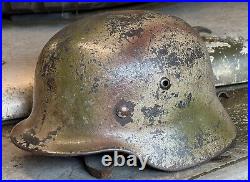
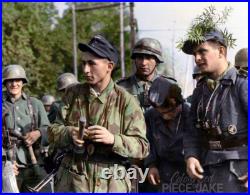
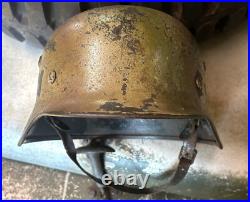
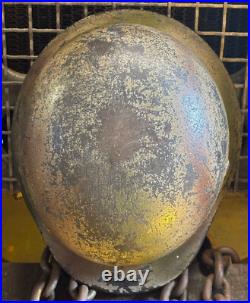
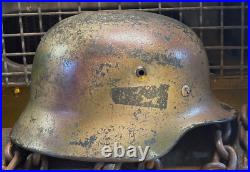
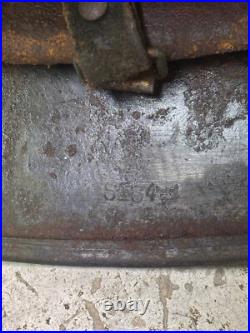
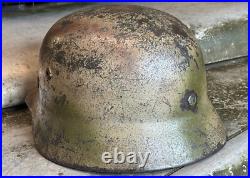
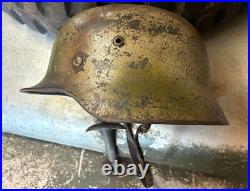
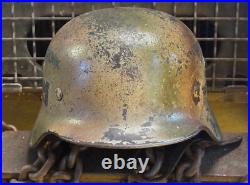
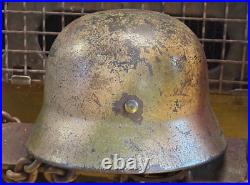

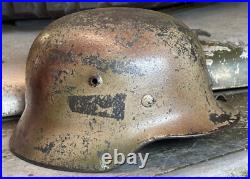
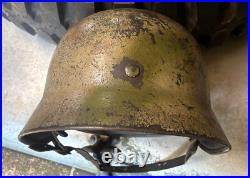
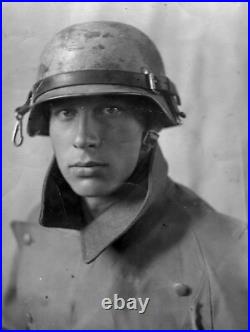
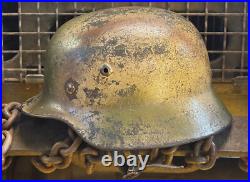
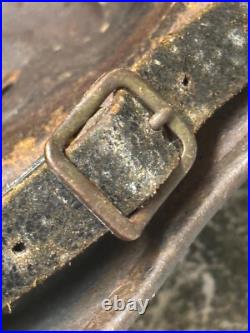
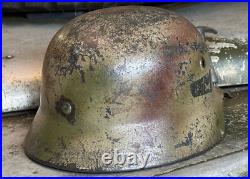
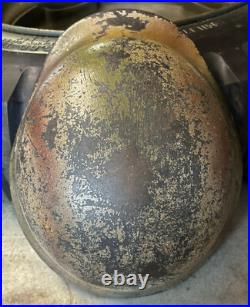
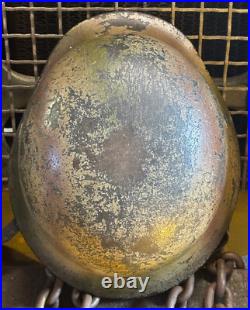

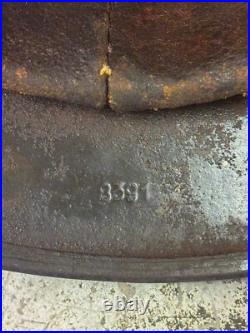
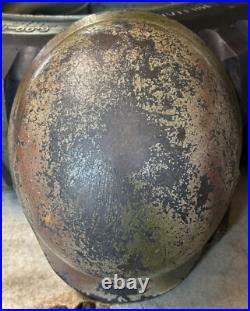
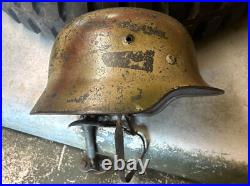
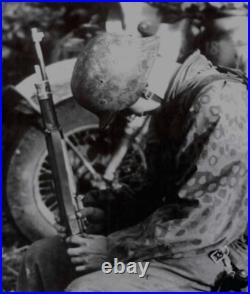

A GENUINE SECOND WORLD WAR GERMAN M40 STAHLHELM (STEEL HELMET), SIZE 64, PRODUCED BY. SÄCHSISCHE EMAILLER UND STANZWERKE A. WITH THE SE 64 CODE AND HEATING LOT NUMBER 8391 STAMPED ON THE NECK GUARD INDICATING THAT IT WAS MANUFACTURED IN MID 1941. ITS FITTED WITH ITS ORIGINAL LINER BAND, LEATHER LINER AND CHINSTRAP AND RETAINS ITS GENUINE 3 COLOR CAMOUFLAGE SCHEME, OFTEN CALLED’NORMANDY CAMO’ BY COLLECTORS. IT HAS NO DECALS. This is an outstanding and genuine example of a Second World War German Mod. Painted in its original, wartime applied, 3 color camouflage scheme over its standard regulation feldgrau (field grey) finish. This 3 color camo scheme is often, but incorrectly, referred to as’Normandy Camo’ by collectors even though it was in widespread use by mid 1944. The manufacturers code stamped into the left hand side of the neck guard is SE64 and the heating lot number 8391, indicating that it was manufactured in late 1943 by Sächsische Emailler und Stanzwerke A. / Lauter as a size 64 shell. The helmet retains its genuine and original M31. Second Pattern Zinc plated steel liner. Band, leather liner and M27 chinstrap. This genuine 3 color camo helmet is in superb original condition and has not been restored, renovated or repainted. The original factory applied wartime dark feld-grau paint remains on the inside of the shell. The authentic spray painted 3 color camouflaged finish is approximately 75% complete and is very good. Although often referred to as’Normandy Camo’ by collectors, mistakenly as it turns out, this paint scheme resulted from a direction from the German high command in mid 1943 that a three color. Camouflaged scheme of tan, green and brown be applied to vehicles and other equipment. The M31 – Second Pattern Zinc plated steel liner system is original to the helmet with all three split pin rivet fasteners intact with their slotted washers with some patination visible (see pictures). The leather liner, now missing its drawstring, which is torn on one tongue and shows evidence of aged mildew, as well as the M27 chinstrap, are original to this helmet and are in very good condition consistent with age and use. The M27 chinstrap is stamped on the strap end although that stamp is now unreadable. The German helmet of World War II is often broken down for distinction in three different models. The M35, M40 and M42. According to the German high command there was only one model, the Model 35, so called because the first years of production was in 1935. The other models, the M40 and M42 do not exist in German military records. The reason for this is that the German military did not consider the later two versions to be new models, just modifications of the original design. The first modification which was intended to speed up production took place on the 26th March 1940. The air vents on both sides of the helmet would be embossed into the steel instead of being a separate piece. The steel would change as well, to a heavier manganese-silicon steel. The final modification was ordered by the German high command on 6th June 1942. As an economic measure the helmet’s rolled edge would be discontinued in favour of a raw edge. The method of manufacture would change as well. The original method of slow press forming in combination with over-heated tempering which had to be done in multiple steps was changed to a rapid hot-stamping method which could produce the helmet in four simplified steps. Close to the Czechoslovakian border the helmet factory of. Sächsische Emailler und Stanzwerke A. Manufactured stahlhem for the Third Reich’s Wehrmacht, Polizei and Waffen-SS. Up until 1943 helmets made by Sächsische Emaillier und Stanzwerke were marked with the code letters ” SE ” visible on this example. In 1943 the firm changed to the new shell code marking “hkp”. The code was initially stamped into the inside left rim but in late 1943 the stamping was moved to the rear of the helmet where it remained until May 1945. Sächsische Emaillier und Stanzwerke A. Was the second largest producer of German steel helmets (Stahlhelme) during the Second World War. Attached to this listing for reference are three period photographs showing German soldiers wearing similar M40’s. The first image, a superb, colorized picture taken during Operation Market Garden in September 1944 shows troops from the Luftwaffe, Heer and Police, part of a hastily assembled Kampfgruppen, in Keizer Lodewijkplein, Nijmegen, Holland. Interestingly, a number of the men shown appear to be wearing similar helmets. The second image shows a German soldier wearing a simililary camouflaged stahlhelm staring at the camera in what appears to be a studio photograph. The last picture shows an exhausted German soldier wearing a camouflaged M40. From Australia, a superb & genuine. Second World War German, 3 color camo size 64, Mod. Steel helmet manufactured in mid 1941 by. Fitted with its original. Second Pattern zinc plated steel liner. Band, liner & chinstrap, its painted with its original and genuine 3 color’Normandy’ camouflage scheme over regulation feldgrau (field grey) with no decals. This helmet has not been restored, refurbished or repainted and is in superb original condition. It’s a cracking example of one of the most sought after helmets of WW2 and one of the most honest of its type I’ve listed. There are no proscribed or banned symbols anywhere on this item.
